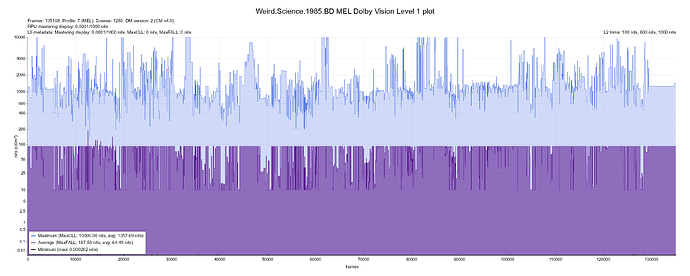Yes will take the native DV:
Thank you @cpm
On another topic I would love to get your feedback on a debate that is happening on another forums (not CE) about LLDV. I have posted this question on another CE thread and got good feedback but since you coded your great enhancements to CE including for player-led HDR and LLDV I would love to have you feedback also.
The debate is about what Dolby Vision profiles can be used by standard DV and by LLDV. Some people are claiming that LLDV is tied/locked to profile 5 or profile 8 and cannot do profile 7 FEL? From what I have seen and tested DV or LLDV are not tied/locked to any profiles and DV and LLDV can use any profile? There are further claims that for LLDV to work with profile 7 FEL (meaning you can see the P7 FEL layer) that the source device is converting it to profile 5 (or 8) to be used by LLDV which does not make sense to me? Does your CE code enhancements with the Ugoos AM6B+ has any of these profile limitations or profile conversion to be used for LLDV? Any official Dolby documentation/technical notes that explain DV/LLDV use of different profiles either way? Thank you.
The DV processing is mainly a Dolby black box.
For DV-LL, processing to a final video image is all on the player and a final image sent to the display.
For DV-Std the processing is split reshaping and composing as required at the player then tone mapping at the display.
No idea what the thinking is behind P7 to P5 or P8 is.
In both DV-LL and DV-Std with a P7 FEL the reshaping and composing in both cases is done on the player, the difference is where the tone mapping processing is done.
First and foremost thank you very much for your work on this one. I’m using the edid_override setting, and when my panel comes back from sleep (turning off) the override fails (which kills my LLDV, and does the classic purple/green). Is there anything that can be done to improve this?
Yeah don’t know how to solve that.
Could someone verify if HDR conversion works at 60Hz with Dolby Vision on their TV?
If the video has both DV and HDR10+ layers, which one will be picked for playback?
already answered before, DV.
I confirmed. There is not much 60Hz HDR content, but I used this as the source:
On my LG G2 it successfully converts to DV. Confirm with TV status displaying 60Hz / TV led DV.
Unfortunately, this is not possible since Dolby Vision and HDR10plus are two different algorithms. The metadata and consequently the tone mapping will always be different because of the way Dolby calculates the average brightness metadata (avg_pq). HDR10plus always has much higher average metadata which makes the image slightly darker compared to genuine DV. It should still be better than static HDR10 though.
Here I did a new test file that directly compares both algorithm’s metadata from many scenes with different brightness.
Profile 8 version
Profile 5 version
And here’s the plot in which you can see how higher hdr10plus avg_pq is compared to the dolby vision tunings.
Thanks, my issue was playing 23.976 content at 60hz but it should make no difference. I’ll check with that 60hz content you found too.
Don’t happen to know what the way is?
No, but DV always has much lower AVG metadata compared to the content actual average brightness and it looks like they have some sort of limit/protection that targets 2048 (92nits) when there are bright highlights + low average… I don’t know the exact math but something like: if 90% of the pixels are below 100nits, average pq can never be higher than 92nits regardless of the remaining 10% pixels. This creates metadata that looks like this sometimes.
From your previous plot it also looks like there is also something is going on above that threshold. Maybe only some percentage of the pixels are being used for the all the avg_pq data?
I dont know but the scenes from the test file are demos clips and have quite a high average brightness compared to what we see in movies.
I don’t think it’s possible to know what Dolby does.
Have you done any comparisons for more representative clips?
Movies usually have very low average brightness but generally speaking, HDR10plus or madmeasure.exe always has a higher AVG and higher metadata values always mean darker tone mapping regardless of the content unless the brightness is below your TV target.
DV avg_PQ over 100nits is very rare but high avg in HDR10plus metadata is common: googledrive plots png of basically all the movies.
What would be the best setting for a LG C9 calibrated at 768nits peak? Thank you.
Interesting, thanks! This means that it will be very difficult to adhere to the artistic intent as displayed in the HDR10+ version.
The difference comes from Dolby Vision analysis being done in PQ, while HDR10+ is average for linearized nits.
madVR also uses linearized nits.

